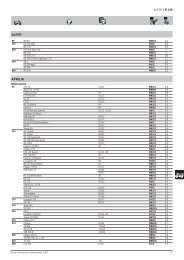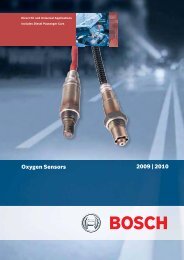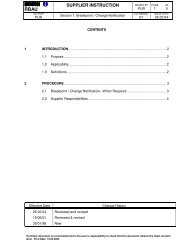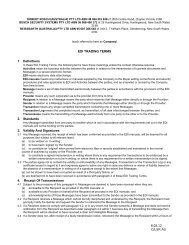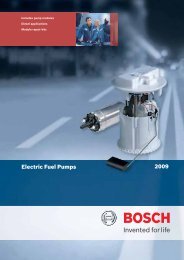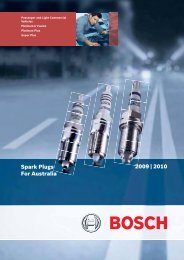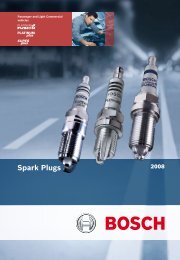For All Vehicles - Bosch Australia
For All Vehicles - Bosch Australia
For All Vehicles - Bosch Australia
Create successful ePaper yourself
Turn your PDF publications into a flip-book with our unique Google optimized e-Paper software.
26<br />
FAQs<br />
If you install additional electrical equipment in the<br />
vehicle, such as amplifiers, navigation systems,<br />
electrical window openers, etc., be sure to also install<br />
a battery with a larger capacity. The original size of<br />
the battery suggested by the vehicle manufacturer<br />
corresponds to the original equipment of the car.<br />
Additional electrical equipment will use up more<br />
energy from the battery and this will result in a<br />
permanent state of low charge if you do not install<br />
a larger battery. A permanent state of low charge<br />
will result in the reduction of the service life of your<br />
battery.<br />
21 It doesn’t seem possible to recharge the discharged<br />
battery.<br />
If a battery is stored for a prolonged period in a state of<br />
low charge, the grids experience sulphation, a process<br />
in which the active material is transformed into white<br />
sulphuric acid (an irreversible state). The longer it is left<br />
in this state, the more difficult it becomes to recharge<br />
the battery. So, recharge any discharged battery as<br />
soon as possible.<br />
A battery with deep discharge should be charged with<br />
1/20 of the capacity of the battery. If it does not recharge<br />
under these conditions, you will need to replace it.<br />
Any attempt to charge it using a larger current will<br />
probably damage it and result in its complete discharge.<br />
Recharging a battery with deep discharge using a highpower<br />
charger will, at best, have no effect or worse<br />
cause permanent damage to the battery.<br />
22 What kind of problems could arise during use?<br />
u Low charge level: This is caused by a defective<br />
alternator, extremely short journeys or an excess<br />
of electrical equipment. Dirty terminals can cause<br />
a loss of current. The battery is not fully charged<br />
and parts of the active material have become<br />
inactive (sulphation). The consequences are a loss<br />
of capacity and reduced starting power.<br />
u Overcharging: This is caused by a defective voltage<br />
regulator. Overcharging results in high water<br />
consumption, extreme electrode corrosion and<br />
severe damage to the battery.<br />
u Strong cyclical use: This is caused by numerous<br />
discharging and recharging deep cycles. Usually,<br />
these charges do not occur under normal<br />
circumstances, unless the starter battery is<br />
frequently activated in congested traffic with lots<br />
of stop-start activity, or when it is used for other<br />
purposes, for example in taxis, to operate loading<br />
platforms on trucks or as a traction battery (there<br />
are special batteries for such applications).<br />
u Wrong size of battery: Choosing a battery with<br />
an inadequate capacity for a vehicle results in a<br />
larger cyclical charge and damage to the battery.<br />
Such damage also results from excessive power<br />
consumption by electrical equipment installed<br />
subsequently (for example, sound systems,<br />
portable telephones, stationary heating).<br />
23 How can I do a simple check for poor battery<br />
operation?<br />
Perform the following list of steps, one at a time, to<br />
check the state of the battery.<br />
1. Check the outer surfaces of the battery. Damage<br />
(for example, cracks) to the external surface of the<br />
battery can cause leakage of electrolyte which, in<br />
turn, results in corrosion of the car. A dirty battery<br />
surface can cause discharge. So, keep it as clean<br />
as possible. Use only a damp anti-static cloth for<br />
cleaning.<br />
2. Check the charge indicator. <strong>Bosch</strong> S5 and S6<br />
starter batteries are fitted with a charge indicator.<br />
It is a fast and convenient way to get a first<br />
impression on the state of charge of the battery.<br />
3. Measuring the voltage (OCV). Let the car engine<br />
rest for about one hour after switching it off before<br />
measuring the voltage. Based on the measured<br />
value of the voltage, you can work out the state<br />
of charge. The voltage of your battery should be<br />
between 12.2V and 12.8V. A voltage that is lower<br />
or higher may be an indication that there is a<br />
fault in the electrical system of the car or that<br />
the battery is damaged. In these cases, have the<br />
battery checked at an authorized workshop.<br />
4. Check the battery using a professional battery<br />
testing instrument. Check with the nearest<br />
authorised dealer for more information concerning<br />
the state of the battery.<br />
24 What are some of the causes of battery discharge in<br />
a car?<br />
u <strong>For</strong>getting to turn off electrical equipment, for<br />
example, fog lights or improperly shut doors that<br />
keep the dome light switched on.<br />
u The electricity load exceeds the capacity of the<br />
vehicle’s alternator. <strong>For</strong> example, when the car is<br />
stopped the generator supplies only 10% to 30%<br />
of its capacity. Discharge may occur if there is an<br />
excessive demand for electrical power at such a<br />
time.<br />
u An increase in the number of electrical accessories<br />
in the car. The capacity of the generators may not<br />
be adequate for feeding all the accessories.<br />
u Long journey times at low speed or electrical<br />
overcharging during night trips. <strong>For</strong> example,<br />
driving in urban traffic, proceeding with many<br />
stops and starts, or on congested roads, together<br />
FAQs<br />
with an excessive use of the air conditioning or<br />
other electrical components.<br />
u Problems with the voltage regulator or with<br />
electrical components.<br />
u Loose connections between the terminals and the<br />
cables.<br />
u Leaving the vehicle parked for long periods of<br />
time.<br />
u Poor operation of the starting device (ignition),<br />
requiring excessive ignition.<br />
u Loose fan belts, which reduces the capacity of the<br />
generator.<br />
u The wearing of wire insulations in older cars<br />
caused by abrasion, which can cause the current<br />
to leak to other parts of the car.<br />
u<br />
Spent batteries.<br />
25 What should I do with my old or damaged battery?<br />
Car batteries contain lead and sulphuric acid. These<br />
materials are hazardous if disposed of in regular<br />
refuse or thrown out in the open. Most of the battery<br />
and its materials are recyclable. To help protect the<br />
environment, adhere to the following instructions:<br />
u Never dispose of spent batteries or their<br />
components in domestic refuse.<br />
u Stores, manufacturers, importers and scrap<br />
dealers take spent batteries and send them on<br />
to secondary foundries for recycling. When you<br />
buy a new battery, hand in the spent one to the<br />
workshop.<br />
u If a battery is destroyed or damaged, the leaked<br />
electrolyte, lead plates and separators should not<br />
be disposed of in domestic refuse. Place these<br />
materials in an acid-resistant box and return<br />
them as you would do with any other spent or<br />
undamaged battery.<br />
u The electrolyte and diluted sulphuric acid should<br />
never be emptied [by someone] without specific<br />
technical knowledge. Never allow the electrolyte<br />
to get into the sewer system, the soil or the water<br />
table.<br />
26 Can the batteries be recycled?<br />
At present, lead-acid batteries are used in practically<br />
all vehicles.<br />
How is the battery recycled?<br />
u The acid of the battery is recycled by neutralising<br />
it in water or by converting it into sodium-sulphate<br />
or powdered detergent, or by using it in glass and<br />
textile production.<br />
u The plastic is recycled by cleaning up the battery<br />
container, melting it down and transforming it into<br />
plastic pellets which will be used once again for<br />
manufacturing batteries.<br />
u The lead, which accounts for 50% of each battery,<br />
is melted down into bars and refined. The lead<br />
retains all its characteristics after having been<br />
refined and can be used for the production of new<br />
batteries.<br />
27



